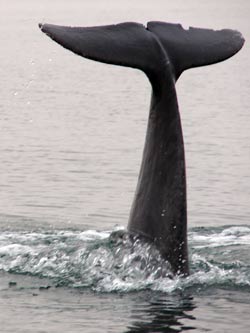Dolphin Flukes

www.mundoazul.org/english/ studies_dolphins.htm
A dolphin's tail or fluke oscillates
in the water causing the dolphin to propel forward. Flukes are
designed to have pleats on them, with the lower surface of the tail
having more pleats than the upper surface. When the fluke is
raised up against the resistance of the water, the pleats allow the
fluke to bend. When the fluke is moved downwards, the pleats
on the lower side open and cause the fluke to bend even more.
Also the muscles in the tail allow it to bend in two places because it does not contain any bone. These "hinges" allow the tail and the end of the tail or wing to never be in a straight line. If they were ever to be in a straight line the dolphin would feel no propulsion because the sum of the propelling force, the normal force, and the lateral force would equal zero.
The force that makes the tail bend at the "hinge" points is water. Newton's Third Law states that "To every action there is an equal and opposite reaction." So for the water pushing up on the fluke, the fluke exerts the same force down on the water at those two exact points.
Return To Main Go To Eels Fish Jellyfish
Also the muscles in the tail allow it to bend in two places because it does not contain any bone. These "hinges" allow the tail and the end of the tail or wing to never be in a straight line. If they were ever to be in a straight line the dolphin would feel no propulsion because the sum of the propelling force, the normal force, and the lateral force would equal zero.
The force that makes the tail bend at the "hinge" points is water. Newton's Third Law states that "To every action there is an equal and opposite reaction." So for the water pushing up on the fluke, the fluke exerts the same force down on the water at those two exact points.
Return To Main Go To Eels Fish Jellyfish